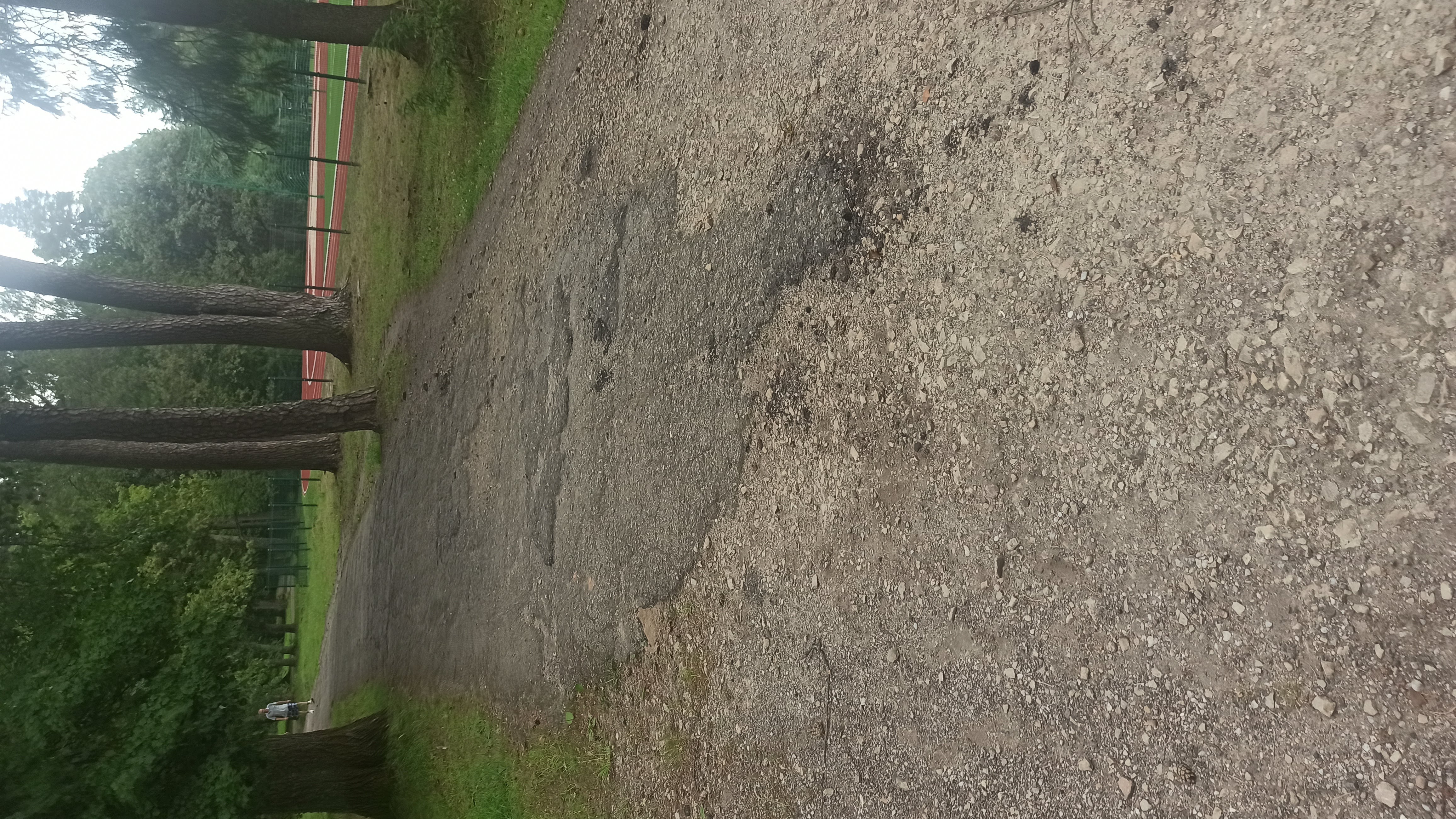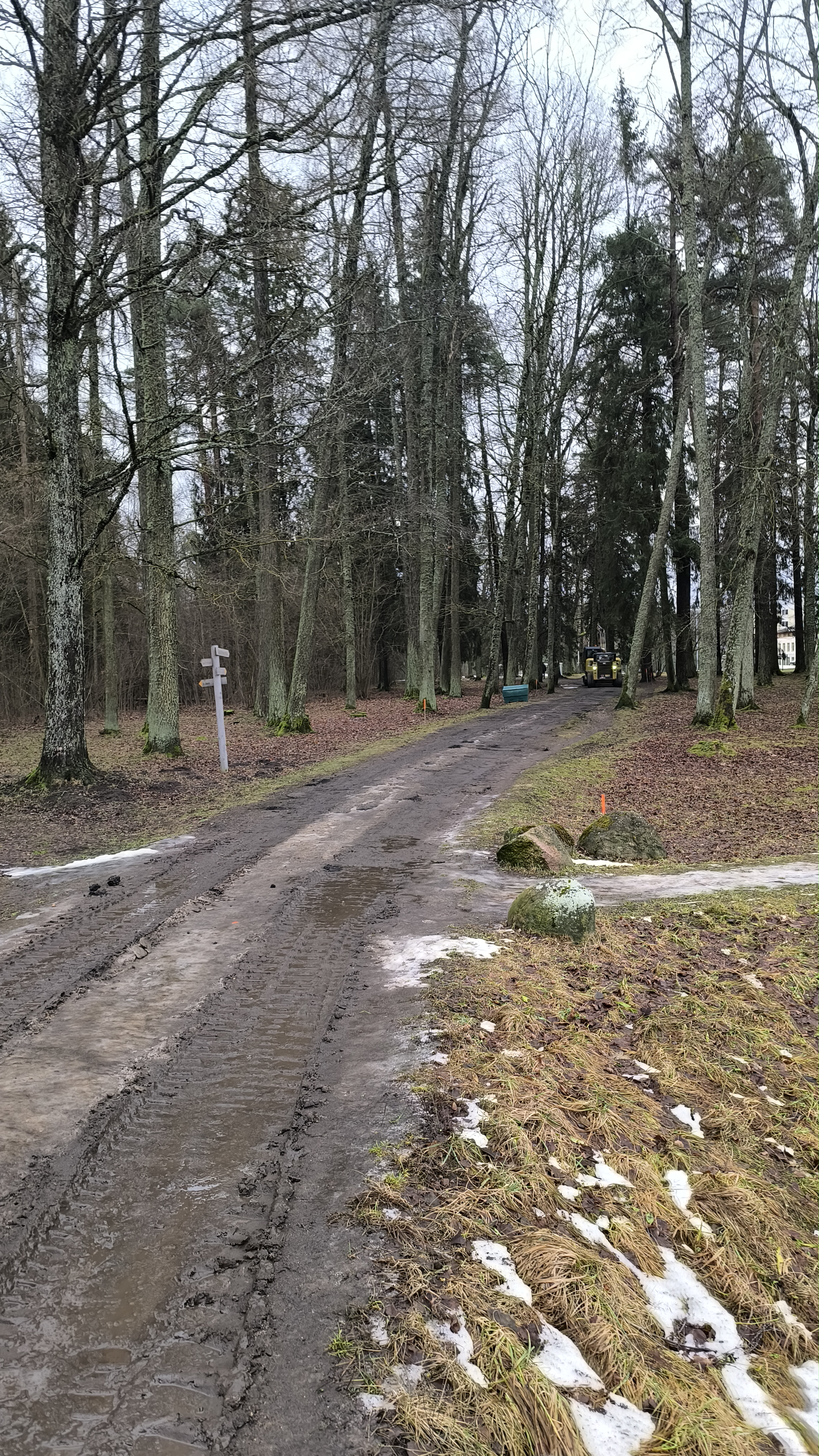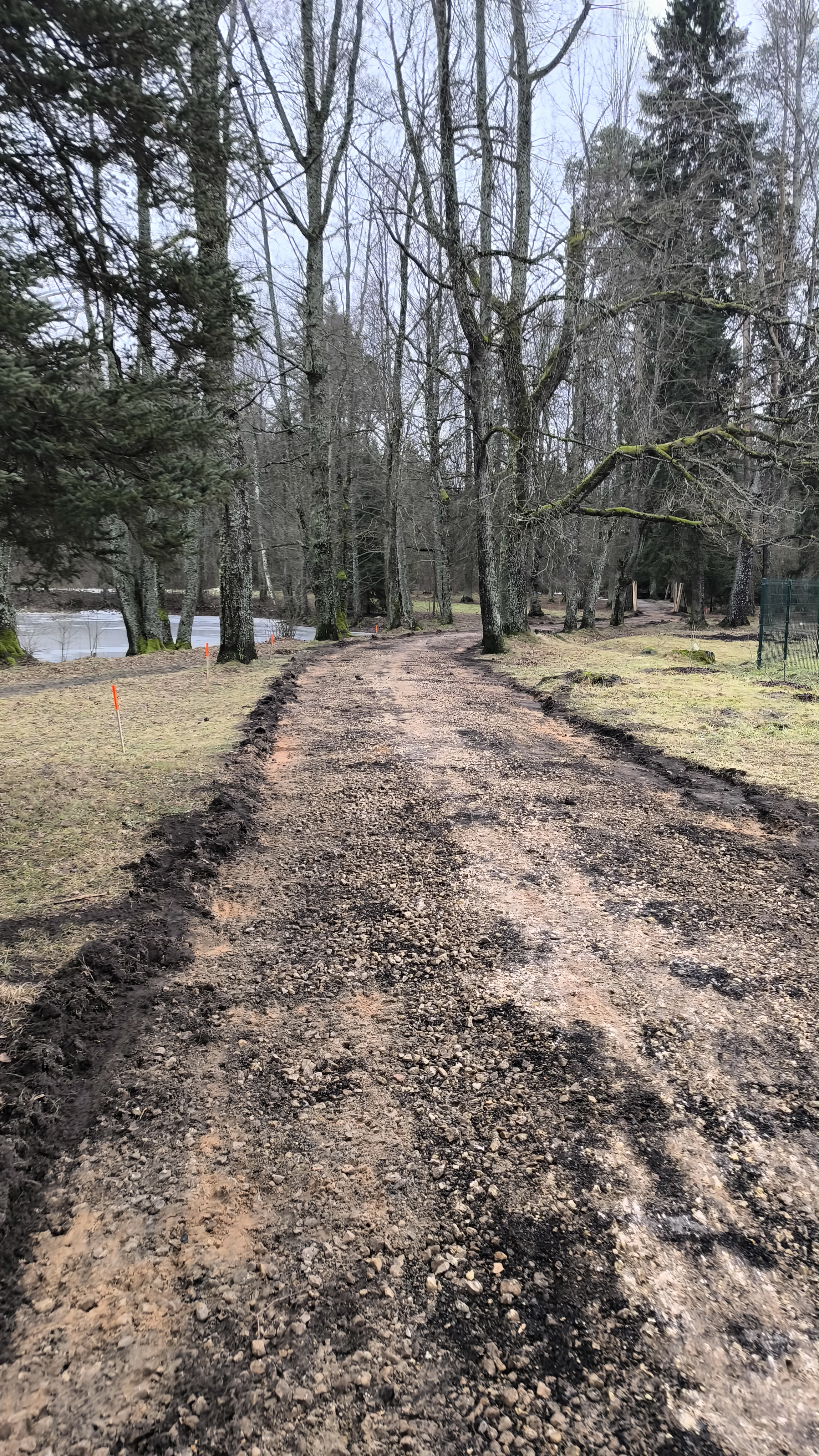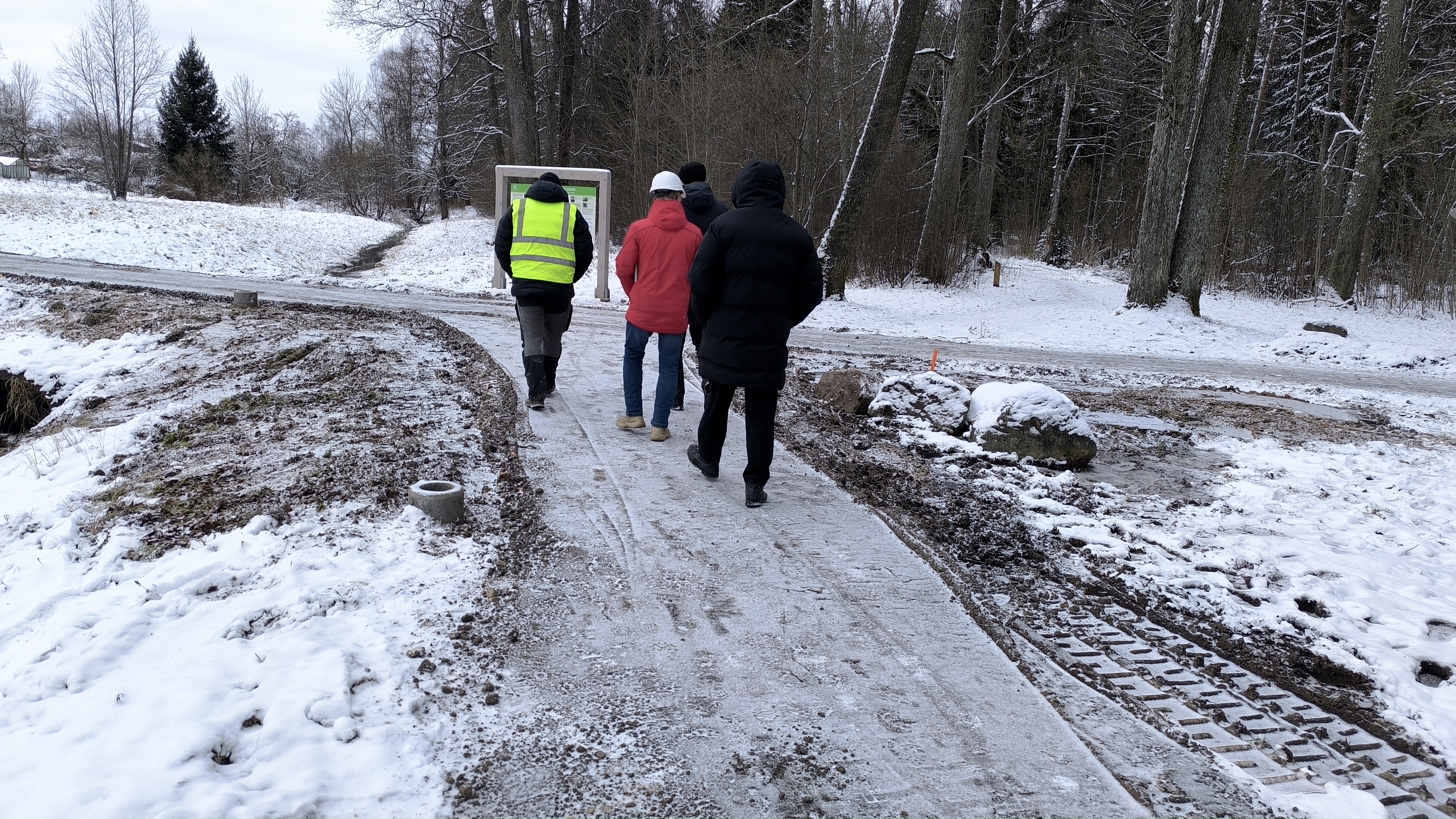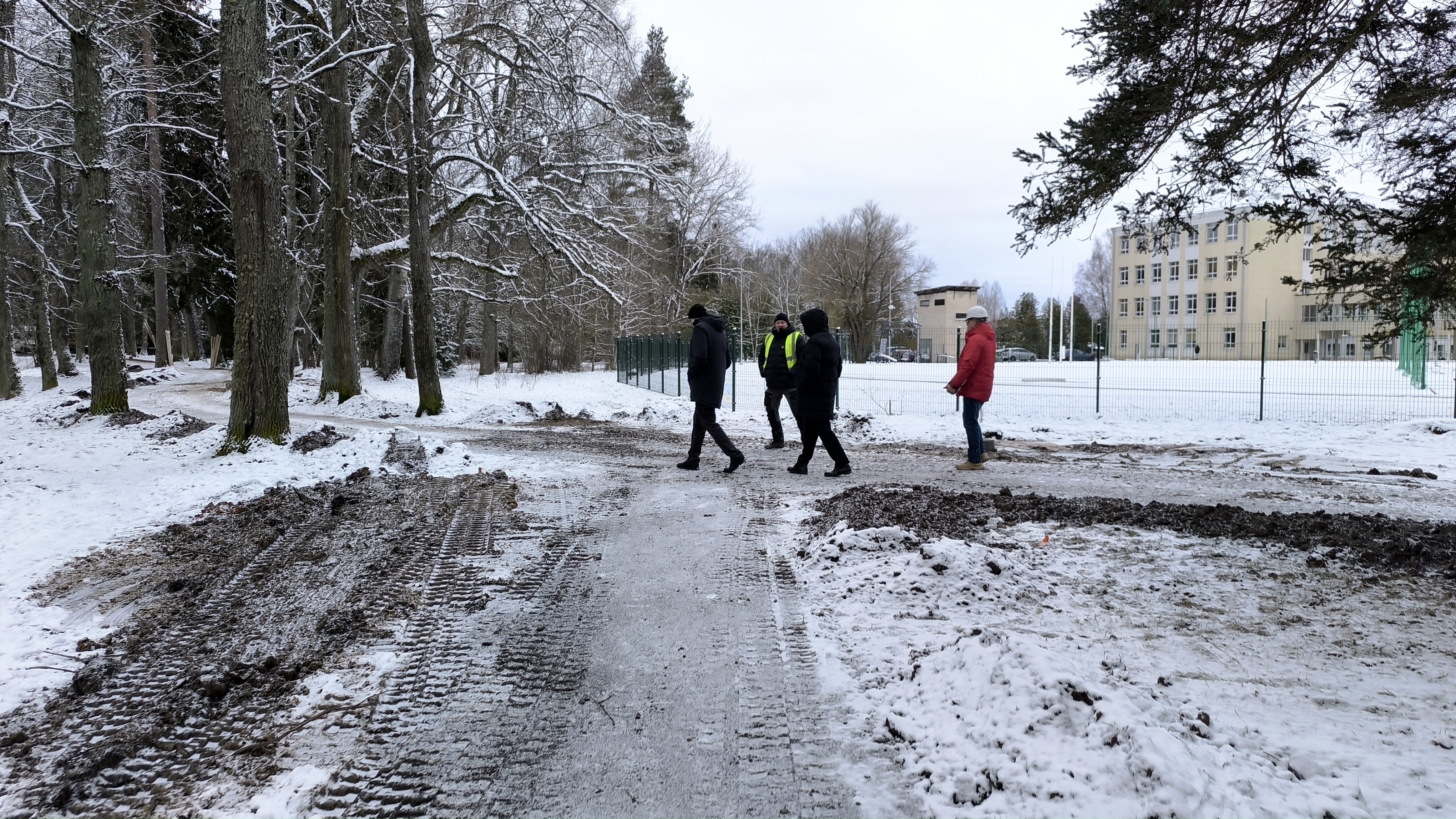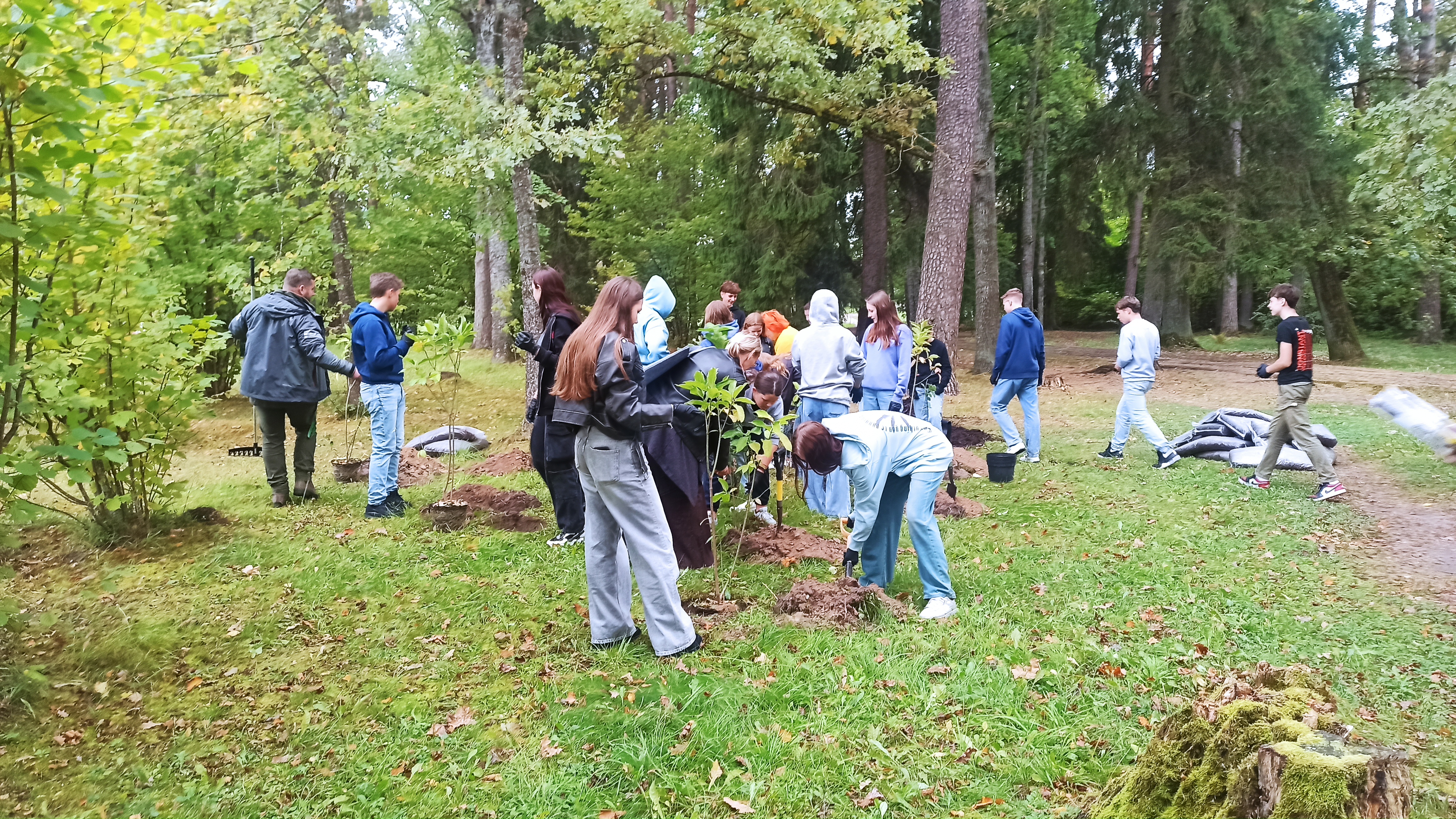Spārīte Park
Renewal of the sidewalk of Spārīte Park
Spārīte Park, part of the historic Marija Park (now merged with Emze Park), is a popular destination for both residents and visitors. Through the NGO "Dēms", residents submitted project proposals for Spārīte Park’s pathway renovation to the municipality’s Participatory Budgeting Project competition in 2023. after discussions between the municipality and project initiators, additional funding was allocated to install lighting alongside the pathway renovation. The project is now underway.
Latvia
Gulbenes novads, Gulbene, Blaumaņa Street 27B, Skolas Street 8C, Spārīte park (from the sidewalk of the Brothers' Cemetery to Sporta Street and to Skolas Street)
Prototype level
Yes
Yes
Yes
No
No
0029000: Gulbenes novads (LV)
The renovation of the walkway in Spārīte Park in Gulbene is an initiative aimed at improving the park's infrastructure and accessibility. The project was initiated by the residents of Gulbene, who voted for it in the 2023 Gulbene Municipality Participation Budget project competition. The renovation work began in January 2025 and is expected to be completed by July 22, 2025.
The overall aim of the project is to create a more comfortable and accessible environment for all park visitors, including families with children, the elderly, and people with disabilities. The specific objective is to renovate the existing walkway and install new lighting.
The expected outcomes of the project include a safer and more convenient walkway for pedestrians, improved lighting to enhance safety and visibility in the park, and increased accessibility for all park visitors.
The overall aim of the project is to create a more comfortable and accessible environment for all park visitors, including families with children, the elderly, and people with disabilities. The specific objective is to renovate the existing walkway and install new lighting.
The expected outcomes of the project include a safer and more convenient walkway for pedestrians, improved lighting to enhance safety and visibility in the park, and increased accessibility for all park visitors.
Community involvement in decision-making
Environmental sustainability
Inclusivity
Transparent governance to enhance public trust
Collaboration
The renovation of the walkway in Spārīte Park in Gulbene aligns with key sustainability principles, encompassing environmental, social, and economic aspects.
Environmental Sustainability: The project focuses on improving park infrastructure, including walkway resurfacing and new lighting installations. The updated lighting system will use energy-efficient LED technology, reducing energy consumption and lowering carbon emissions. Additionally, enhancing the walkway promotes pedestrian movement, which is a more environmentally friendly mode of transportation compared to motorized vehicles.
Social Sustainability: The renewed walkway improves accessibility and safety for all park visitors, including individuals with mobility impairments and parents with strollers. This fosters greater community engagement and well-being by creating an attractive and secure space for recreation and social interaction.
Economic Sustainability: The project was chosen based on a public vote as part of the 2023 Gulbene Municipality Participatory Budget Initiative, highlighting strong community involvement and support. This approach ensures the efficient use of resources by addressing residents' priorities and needs. Additionally, improved infrastructure can attract more visitors to the park, potentially benefiting the local economy.
Overall, the renovation of Spārītes Park’s walkway integrates sustainability principles by enhancing environmental quality, promoting social well-being, and ensuring economic viability.
Environmental Sustainability: The project focuses on improving park infrastructure, including walkway resurfacing and new lighting installations. The updated lighting system will use energy-efficient LED technology, reducing energy consumption and lowering carbon emissions. Additionally, enhancing the walkway promotes pedestrian movement, which is a more environmentally friendly mode of transportation compared to motorized vehicles.
Social Sustainability: The renewed walkway improves accessibility and safety for all park visitors, including individuals with mobility impairments and parents with strollers. This fosters greater community engagement and well-being by creating an attractive and secure space for recreation and social interaction.
Economic Sustainability: The project was chosen based on a public vote as part of the 2023 Gulbene Municipality Participatory Budget Initiative, highlighting strong community involvement and support. This approach ensures the efficient use of resources by addressing residents' priorities and needs. Additionally, improved infrastructure can attract more visitors to the park, potentially benefiting the local economy.
Overall, the renovation of Spārītes Park’s walkway integrates sustainability principles by enhancing environmental quality, promoting social well-being, and ensuring economic viability.
The renovation of the walkway in Spārīte Park, is not only a functional upgrade but also an initiative to enhance the park’s aesthetics and overall visitor experience.
1. Aesthetic Improvements Through Thoughtful Design: 1) Natural Integration: The new walkway harmonizes with the park’s natural landscape, maintaining the scenic beauty and ensuring that modern upgrades do not disrupt its ecological character; 2) Quality Materials and Finishes: Durable and visually appealing materials were chosen to enhance the park’s charm while ensuring longevity and low maintenance; 3) Enhanced Lighting: Energy-efficient lighting installations not only improve safety but also create a warm and inviting atmosphere, encouraging evening strolls and extending the usability of the park beyond daylight hours.
2. Positive Emotions and Well-Being: 1) A More Enjoyable Walking Experience: A smoother, safer, and more visually pleasant walkway makes walking more comfortable and enjoyable for all visitors, promoting relaxation and leisure; 2) Encouraging Community Interaction: The improvements provide a welcoming space for social gatherings, fostering a sense of connection and community belonging; 3) A Sense of Pride and Ownership: Since the project was chosen through participatory budgeting, local residents have a vested interest in its success, reinforcing civic engagement and community spirit.
3. Cultural and Recreational Benefits: 1) Preserving the Park’s Heritage: The renovation respects the cultural and historical essence of Spārītes Park, ensuring that modernization enhances rather than diminishes its character; 2) Promoting Active Lifestyles: With an improved walkway, the park encourages walking, jogging, and other outdoor activities that support healthy living; 3) Potential for Artistic and Cultural Initiatives: The upgraded space can now better accommodate cultural events, exhibitions, or installations, strengthening the park’s role as a community hub.
1. Aesthetic Improvements Through Thoughtful Design: 1) Natural Integration: The new walkway harmonizes with the park’s natural landscape, maintaining the scenic beauty and ensuring that modern upgrades do not disrupt its ecological character; 2) Quality Materials and Finishes: Durable and visually appealing materials were chosen to enhance the park’s charm while ensuring longevity and low maintenance; 3) Enhanced Lighting: Energy-efficient lighting installations not only improve safety but also create a warm and inviting atmosphere, encouraging evening strolls and extending the usability of the park beyond daylight hours.
2. Positive Emotions and Well-Being: 1) A More Enjoyable Walking Experience: A smoother, safer, and more visually pleasant walkway makes walking more comfortable and enjoyable for all visitors, promoting relaxation and leisure; 2) Encouraging Community Interaction: The improvements provide a welcoming space for social gatherings, fostering a sense of connection and community belonging; 3) A Sense of Pride and Ownership: Since the project was chosen through participatory budgeting, local residents have a vested interest in its success, reinforcing civic engagement and community spirit.
3. Cultural and Recreational Benefits: 1) Preserving the Park’s Heritage: The renovation respects the cultural and historical essence of Spārītes Park, ensuring that modernization enhances rather than diminishes its character; 2) Promoting Active Lifestyles: With an improved walkway, the park encourages walking, jogging, and other outdoor activities that support healthy living; 3) Potential for Artistic and Cultural Initiatives: The upgraded space can now better accommodate cultural events, exhibitions, or installations, strengthening the park’s role as a community hub.
The renovation of the walkway in Spārīte Park, is guided by a strong commitment to inclusion, ensuring that the space is accessible, welcoming, and beneficial to all members of society.
1. Accessibility for All: 1) Barrier-Free Mobility: The renovated walkway is designed to accommodate people with diverse mobility needs, including wheelchair users, elderly individuals, and parents with strollers, ensuring a seamless and safe experience; 2) Enhanced Safety Measures: Improved surface materials and well-placed lighting enhance safety, preventing trip hazards and enabling confident use, even during nighttime hours; 3) User-Friendly Design: The walkway’s width and layout facilitate easy navigation, accommodating both individuals and groups, whether they are walking, jogging, or using mobility aids.
2. Affordability and Public Benefit: 1) A Free and Open Space: Spārītes Park remains a fully public and cost-free area, ensuring that everyone, regardless of income, can enjoy a high-quality environment for leisure, exercise, and socializing; 2) Encouraging Sustainable Mobility: By improving walkability, the park supports pedestrian-friendly lifestyles, reducing reliance on private vehicles and promoting an equitable urban mobility model.
3. Inclusive Governance and Community Participation: 1) Participatory Decision-Making: The project was selected through a public vote as part of the 2023 Gulbene Municipality Participatory Budget Initiative, ensuring that it directly reflects the needs and desires of the local community; 2) Strengthening Civic Engagement: The initiative fosters a sense of community ownership, encouraging residents to take an active role in shaping their environment; 3) Collaboration Across Stakeholders: The project brings together local authorities, urban planners, and residents, showcasing a model of inclusive governance that prioritizes collective well-being.
1. Accessibility for All: 1) Barrier-Free Mobility: The renovated walkway is designed to accommodate people with diverse mobility needs, including wheelchair users, elderly individuals, and parents with strollers, ensuring a seamless and safe experience; 2) Enhanced Safety Measures: Improved surface materials and well-placed lighting enhance safety, preventing trip hazards and enabling confident use, even during nighttime hours; 3) User-Friendly Design: The walkway’s width and layout facilitate easy navigation, accommodating both individuals and groups, whether they are walking, jogging, or using mobility aids.
2. Affordability and Public Benefit: 1) A Free and Open Space: Spārītes Park remains a fully public and cost-free area, ensuring that everyone, regardless of income, can enjoy a high-quality environment for leisure, exercise, and socializing; 2) Encouraging Sustainable Mobility: By improving walkability, the park supports pedestrian-friendly lifestyles, reducing reliance on private vehicles and promoting an equitable urban mobility model.
3. Inclusive Governance and Community Participation: 1) Participatory Decision-Making: The project was selected through a public vote as part of the 2023 Gulbene Municipality Participatory Budget Initiative, ensuring that it directly reflects the needs and desires of the local community; 2) Strengthening Civic Engagement: The initiative fosters a sense of community ownership, encouraging residents to take an active role in shaping their environment; 3) Collaboration Across Stakeholders: The project brings together local authorities, urban planners, and residents, showcasing a model of inclusive governance that prioritizes collective well-being.
The renovation of the walkway in Spārītes Park, Gulbene, is a community-driven initiative that actively involves citizens and civil society at various stages, from decision-making to implementation and long-term stewardship. This participatory approach ensures that the project meets real local needs, fosters civic engagement, and strengthens the social fabric.
The municipality has encouraged continued community dialogue and feedback to ensure the project remains aligned with public expectations.The initiative fosters a sense of collective ownership, motivating residents to take care of the renovated space and report any necessary improvements.Every year, residents and students participate in planting greenery in the park, following recommendations from the 2020 report on Spārīte Park’s dendrological plantings, landscape condition, and maintenance measures. These activities help locals learn more about the park’s maintenance and biodiversity. Students find that working together with municipal staff to improve the park fosters a sense of responsibility and pride. Each spring, residents gather to clean and revitalize the park after winter.
When communities are actively involved in shaping public spaces, they are more likely to take care of them, leading to better long-term maintenance and sustainability. The project has the potential to inspire further community-led initiatives, reinforcing a culture of collaborative urban development.
The municipality has encouraged continued community dialogue and feedback to ensure the project remains aligned with public expectations.The initiative fosters a sense of collective ownership, motivating residents to take care of the renovated space and report any necessary improvements.Every year, residents and students participate in planting greenery in the park, following recommendations from the 2020 report on Spārīte Park’s dendrological plantings, landscape condition, and maintenance measures. These activities help locals learn more about the park’s maintenance and biodiversity. Students find that working together with municipal staff to improve the park fosters a sense of responsibility and pride. Each spring, residents gather to clean and revitalize the park after winter.
When communities are actively involved in shaping public spaces, they are more likely to take care of them, leading to better long-term maintenance and sustainability. The project has the potential to inspire further community-led initiatives, reinforcing a culture of collaborative urban development.
Local Level: Community and Municipal Involvement
At the local level, the project was largely citizen-driven and supported by the Gulbene Municipality through participatory governance structures. The issue of park paths is regularly brought up at residents' meetings organized by Citizens & Civil Society Organizations "Dēms" and "SATEKA".
The municipality provided technical oversight, funding allocation, and project coordination. Local urban planners, engineers, and environmental specialists ensured that the walkway met design, safety, and sustainability standards.
Environmental & Cultural Heritage Organizations (for exampl Vineta Radziņa): Advised on the preservation of natural and cultural elements of Spārīte Park, ensuring that the renovation was sensitive to the park’s ecological and historical value; Helped implement measures to minimize environmental impact and promote biodiversity-friendly urban planning.
European Level The project supports the EU’s Green Deal goals for sustainable cities, energy efficiency (LED lighting), and eco-friendly mobility.
At the local level, the project was largely citizen-driven and supported by the Gulbene Municipality through participatory governance structures. The issue of park paths is regularly brought up at residents' meetings organized by Citizens & Civil Society Organizations "Dēms" and "SATEKA".
The municipality provided technical oversight, funding allocation, and project coordination. Local urban planners, engineers, and environmental specialists ensured that the walkway met design, safety, and sustainability standards.
Environmental & Cultural Heritage Organizations (for exampl Vineta Radziņa): Advised on the preservation of natural and cultural elements of Spārīte Park, ensuring that the renovation was sensitive to the park’s ecological and historical value; Helped implement measures to minimize environmental impact and promote biodiversity-friendly urban planning.
European Level The project supports the EU’s Green Deal goals for sustainable cities, energy efficiency (LED lighting), and eco-friendly mobility.
In 2020, SIA “Laba Vide” (Forestry Engineer, Landscape Designer) conducted an assessment of Spārītes Park in Gulbene, evaluating its dendrological plantings, overall condition, and recommended maintenance measures. This study was commissioned by the Gulbene Municipality.
Based on the findings, the municipality’s landscape architect and urban maintenance department carried out park upkeep efforts, organized community clean-up events, planted ornamental shrubs, and implemented other improvement measures.
Following community-driven initiatives and the project’s approval, the municipality launched a procurement process for the design phase. The design was developed by SIA “4. stils”, which laid the groundwork for the construction tender.
The construction contract was awarded to SIA “LV ROADS”, which is currently working on the walkway renovation. The project is scheduled for completion by July 22, 2025.
For project updates, visit: https://balso.gulbene.lv/projekti/sparites-parka-ietves-atjaunosana-0.
Based on the findings, the municipality’s landscape architect and urban maintenance department carried out park upkeep efforts, organized community clean-up events, planted ornamental shrubs, and implemented other improvement measures.
Following community-driven initiatives and the project’s approval, the municipality launched a procurement process for the design phase. The design was developed by SIA “4. stils”, which laid the groundwork for the construction tender.
The construction contract was awarded to SIA “LV ROADS”, which is currently working on the walkway renovation. The project is scheduled for completion by July 22, 2025.
For project updates, visit: https://balso.gulbene.lv/projekti/sparites-parka-ietves-atjaunosana-0.
The renovation of the Spārītes Park walkway in Gulbene stands out as an innovative and forward-thinking initiative when compared to conventional urban infrastructure projects. Instead of merely focusing on basic functionality and standard refurbishment, this project integrates cutting-edge sustainability, participatory governance, and inclusive design principles, making it a model for modern public space renewal.
1) Unlike conventional infrastructure projects that are typically decided solely by municipal planners, this initiative was directly chosen by residents through a participatory budgeting process. The project empowers citizens, fostering a sense of ownership and engagement, which is rarely seen in standard urban planning approaches. This co-creation process ensures that the final result meets real community needs, rather than being a top-down administrative decision. Innovative Impact: A democratic and community-driven approach to urban development that strengthens civic engagement.
2) While most public infrastructure projects offer limited public insight into progress and decision-making, this initiative embraces digital transparency.
Project progress and updates are available online, allowing citizens to track implementation, voice concerns, and stay informed via the official municipal platform. This open governance approach ensures greater accountability and trust between the municipality and the community. Innovative Impact: A digital, transparent, and citizen-engaged approach to project management and oversight.
1) Unlike conventional infrastructure projects that are typically decided solely by municipal planners, this initiative was directly chosen by residents through a participatory budgeting process. The project empowers citizens, fostering a sense of ownership and engagement, which is rarely seen in standard urban planning approaches. This co-creation process ensures that the final result meets real community needs, rather than being a top-down administrative decision. Innovative Impact: A democratic and community-driven approach to urban development that strengthens civic engagement.
2) While most public infrastructure projects offer limited public insight into progress and decision-making, this initiative embraces digital transparency.
Project progress and updates are available online, allowing citizens to track implementation, voice concerns, and stay informed via the official municipal platform. This open governance approach ensures greater accountability and trust between the municipality and the community. Innovative Impact: A digital, transparent, and citizen-engaged approach to project management and oversight.
The Spārītes Park walkway renovation follows a holistic, participatory, and sustainability-driven methodology that integrates multiple disciplines, stakeholders, and innovative urban development strategies. This approach ensures that the project is community-centered, environmentally responsible, and socially inclusive.
The Spārīte Park walkway renovation adopts a multifaceted, research-based, and participatory methodology that prioritizes:
Community involvement in decision-making.
Environmental sustainability through nature-based solutions.
Universal accessibility to promote inclusivity.
Transparent governance to enhance public trust.
Multidisciplinary collaboration for a high-quality urban space.
By integrating social, environmental, and technological innovations, this initiative sets a new standard for urban park development, making it replicable and exemplary for other cities and regions.
The Spārīte Park walkway renovation adopts a multifaceted, research-based, and participatory methodology that prioritizes:
Community involvement in decision-making.
Environmental sustainability through nature-based solutions.
Universal accessibility to promote inclusivity.
Transparent governance to enhance public trust.
Multidisciplinary collaboration for a high-quality urban space.
By integrating social, environmental, and technological innovations, this initiative sets a new standard for urban park development, making it replicable and exemplary for other cities and regions.
The initiative to restore the sidewalk in Spārīte Park incorporates several elements that can be replicated or transferred to other locations, beneficiary groups, and contexts. These include:
1. Community-Driven Participatory Budgeting Model: The project was initiated through a participatory budgeting competition, allowing residents to propose and vote on improvements;This model can be replicated in other municipalities to engage citizens in decision-making and ensure that investments reflect community needs.
2. Sustainable Infrastructure Development:The restoration of pathways focused on accessibility, ensuring they are suitable for individuals with mobility impairments and parents with strollers; The use of durable, environmentally friendly materials and energy-efficient LED lighting can be applied to other parks and public spaces.
3. Environmental and Social Sustainability Approach: The project integrates tree planting and landscape preservation, promoting biodiversity;Annual clean-up and greening activities involving students and residents can be replicated in other urban areas to strengthen community engagement and environmental stewardship.
4. Transparent Communication and Public Involvement:
Residents were continuously updated via online platforms and local media, fostering transparency and trust; This approach can be used in other public projects to improve citizen engagement and accountability.
5. Cross-Sector Collaboration:The project involved partnerships between the municipality, NGOs, and the local community; Similar collaborations can be established elsewhere to maximize resources, expertise, and public participation.
6. Economic Sustainability and Local Impact:By focusing on community needs, the project ensured efficient use of resources while boosting local economic activity through increased park visits; This model can be transferred to other small towns seeking to enhance urban green spaces with limited budgets.
1. Community-Driven Participatory Budgeting Model: The project was initiated through a participatory budgeting competition, allowing residents to propose and vote on improvements;This model can be replicated in other municipalities to engage citizens in decision-making and ensure that investments reflect community needs.
2. Sustainable Infrastructure Development:The restoration of pathways focused on accessibility, ensuring they are suitable for individuals with mobility impairments and parents with strollers; The use of durable, environmentally friendly materials and energy-efficient LED lighting can be applied to other parks and public spaces.
3. Environmental and Social Sustainability Approach: The project integrates tree planting and landscape preservation, promoting biodiversity;Annual clean-up and greening activities involving students and residents can be replicated in other urban areas to strengthen community engagement and environmental stewardship.
4. Transparent Communication and Public Involvement:
Residents were continuously updated via online platforms and local media, fostering transparency and trust; This approach can be used in other public projects to improve citizen engagement and accountability.
5. Cross-Sector Collaboration:The project involved partnerships between the municipality, NGOs, and the local community; Similar collaborations can be established elsewhere to maximize resources, expertise, and public participation.
6. Economic Sustainability and Local Impact:By focusing on community needs, the project ensured efficient use of resources while boosting local economic activity through increased park visits; This model can be transferred to other small towns seeking to enhance urban green spaces with limited budgets.
The initiative to restore Spārīte Park’s sidewalk addresses several global challenges by implementing local solutions, demonstrating how small-scale, community-led projects can contribute to broader sustainability goals.
Climate Change and Environmental Sustainability - The project prioritizes green infrastructure, preserving trees and biodiversity while integrating energy-efficient LED lighting to reduce energy consumption and carbon footprint. Encouraging pedestrian mobility over car use helps lower CO₂ emissions, promoting eco-friendly urban mobility.
Citizen Engagement and Participatory Governance - The initiative was driven by residents’ proposals through participatory budgeting, ensuring the project aligns with community needs. Regular updates through local media and online platforms enhance transparency and trust between citizens and local authorities.
Economic Revitalization of Small Towns - Park improvements attract more visitors, benefiting local businesses and tourism. Increased foot traffic encourages economic activity in surrounding areas, contributing to sustainable local development.
his initiative demonstrates how local action can contribute to solving global challenges. By promoting sustainability, inclusion, and participatory governance, the project serves as a model for other cities and communities seeking effective, people-centered urban development solutions.
Climate Change and Environmental Sustainability - The project prioritizes green infrastructure, preserving trees and biodiversity while integrating energy-efficient LED lighting to reduce energy consumption and carbon footprint. Encouraging pedestrian mobility over car use helps lower CO₂ emissions, promoting eco-friendly urban mobility.
Citizen Engagement and Participatory Governance - The initiative was driven by residents’ proposals through participatory budgeting, ensuring the project aligns with community needs. Regular updates through local media and online platforms enhance transparency and trust between citizens and local authorities.
Economic Revitalization of Small Towns - Park improvements attract more visitors, benefiting local businesses and tourism. Increased foot traffic encourages economic activity in surrounding areas, contributing to sustainable local development.
his initiative demonstrates how local action can contribute to solving global challenges. By promoting sustainability, inclusion, and participatory governance, the project serves as a model for other cities and communities seeking effective, people-centered urban development solutions.
The Spārīte Park sidewalk renovation is part of a broader effort to enhance sustainability, accessibility, and community engagement.
Key Next Steps (2025-2030):
Pathway & Lighting Upgrades: Completion of resurfacing, LED lighting installation, and potential smart lighting integration.
Accessibility & Landscape Improvements: Barrier-free pathways, new seating areas, and climate-resilient tree planting.
Community Engagement & Education: Citizen workshops, annual tree-planting, and biodiversity awareness initiatives.
Sustainable Infrastructure: Feasibility studies for solar-powered stations and smart drainage solutions.
NEB Values & Principles:
Sustainability: Energy-efficient lighting, pedestrian-friendly infrastructure, and biodiversity protection.
Aesthetics: Modernized pathways, nature-inspired design, and seasonal greenery enhancements.
Inclusion: Universal accessibility, participatory budgeting, and community-led decision-making.
This project demonstrates sustainable urban renewal, integrating NEB principles to create an inclusive, eco-friendly, and visually inspiring park that can be replicated in other European communities.
Key Next Steps (2025-2030):
Pathway & Lighting Upgrades: Completion of resurfacing, LED lighting installation, and potential smart lighting integration.
Accessibility & Landscape Improvements: Barrier-free pathways, new seating areas, and climate-resilient tree planting.
Community Engagement & Education: Citizen workshops, annual tree-planting, and biodiversity awareness initiatives.
Sustainable Infrastructure: Feasibility studies for solar-powered stations and smart drainage solutions.
NEB Values & Principles:
Sustainability: Energy-efficient lighting, pedestrian-friendly infrastructure, and biodiversity protection.
Aesthetics: Modernized pathways, nature-inspired design, and seasonal greenery enhancements.
Inclusion: Universal accessibility, participatory budgeting, and community-led decision-making.
This project demonstrates sustainable urban renewal, integrating NEB principles to create an inclusive, eco-friendly, and visually inspiring park that can be replicated in other European communities.

